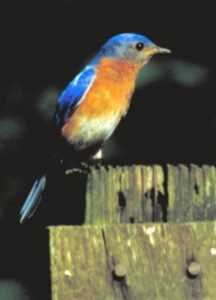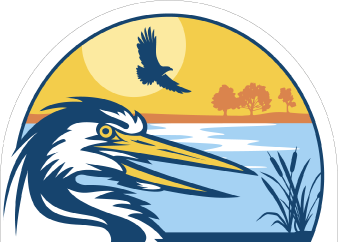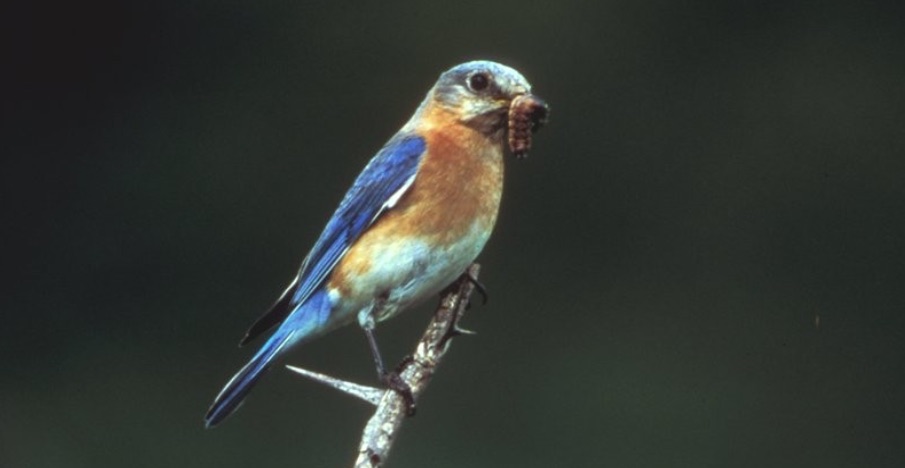
Cavity nesters at the Iroquois National Wildlife Refuge had moderate results in 2013. Due to the cold wet spring most of the birds had a hard time raising their young this year. The bluebirds and tree swallows which nest early were more impacted by the weather than latter nesting birds like purple martins and kestrels.
The bluebird fledglings were down 24% from the 2012 record total of 107. We had several abandon nests with eggs and several chicks that died due to the cold wet nights. The tree swallows had smaller clutches and had many eggs that did not hatch. We banded 277 birds, nearly 100 less chicks than normal.
Click here to become a member!
Click here to donate!
The kestrels got off to a good start and I thought that we might have a record year. However, one nest of five eggs was abandoned and then later the box was smashed by vandals. We think the vandals harassed the birds and caused them to leave, then destroyed the box. This left us with the same number of fledglings (14) that we have had the last two years. This is unfortunate as kestrels are declining in NYS and are in fifth place (if you include the bank swallow as a cavity nester) for the most significant decline of cavity nesting birds according to the 2000-2005 NYS Breeding Bird Atlas.
We had the exact same number of purple martins fledge (286) this year as in 2012. There were more nests but the clutch sizes were down an average of one egg per nest so the number of fledglings remained the same. Again this year we used green color bands on all the chicks as well as the standard USFWS bands. We did observe at least 7 green bands that were from 2012 birds. Some of these were read and we found that some returned to their natal colony and some moved to our colonies at different locations. We are hopeful that we will hear about more of the 2012 birds being sited at other locations in Western NY. We did capture an adult martin that was banded in Savannah, NY at the National Audubon Society site. (About 10 miles north of Seneca Falls, NY). This bird was banded in 2011 as a chick at their colony which is about 85 miles away. We also saw an adult bird with a gold band. We were not able to capture this bird but know that Rich Wells does use gold bands at a colony in Derby, NY and this bird may have been from there. This colony is about 50 miles southwest of our colonies located near the shores of Lake Erie.
This year was another learning year for us and we plan to make several changes to our purple martin program for 2014 to allow us to capture more adult birds with green color bands. This year we tried to use scopes to read bands and this did not prove to be very effective. Capturing birds will allow us to collect better data on birds returning to our colonies, movement between our colonies and birds from other remote locations. Next year we plan some capacity increases by adding more gourds and to improve our fledging rate by attempting to control parasites more aggressively.
Our thanks go out to Bob Schmidt, Celeste Morien and Sandy Mendel who helped to coordinate the nestbox checking activities. We also had help from several other Volunteers, the YCC participants, the TAKA kids and Interns from both the Refuge and Fisheries. This helps to make more people aware of the status of these birds and what is required to help them survive.
As part of the NY State Purple Martin Project it is planned to add a new gourd rack setup at the Batavia Waste Water Facility in Batavia, NY. When complete and at full capacity this rack will include 30 horizontal gourds with the latest in starling resistant Conley II entrances and trap compatibility to capture house sparrows. This project is being funded by a grant from the Buffalo Ornithological Society. Another project is being planned for the Arrowhead Golf Club in Akron, NY. This will be almost identical to the one mentioned above and a request for a grant from the New York State Bluebird Society to assist with funding has been submitted.
So you can see that many things are being worked on to help stabilize the martin population in NY State. However, we have a long way to go to offset the 40 to 60% decline of the last 50 years. To add to this difficulty all of the other States and Canadian Providences surrounding us are also declining at about the same rate so it is a near insurmountable task. However, if we can expand and grow the pockets of martin populations that exist in Western New York State then in time it will have an impact on the overall State population. This is an exciting time and we hope to have all of these changes ready to greet the birds when they return next April.


